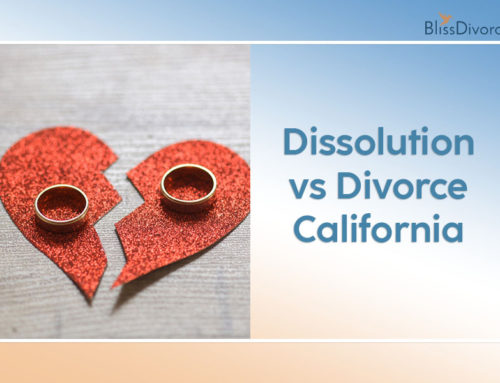Types of Divorce in California: A Legal Guide for Ending a Marriage
Divorce or Legal Separation is difficult no matter where or when you go through it. The process will be dictated by the laws and practices of the state in which you and/or your spouse reside. Like all other states, California has a unique set of divorce laws, with different processes available.
In the article, we will describe the process of Divorce, also known as dissolution of marriage, in California, as well as the advantages and disadvantages of each type of divorce, including divorce mediation. If you’re looking for a divorce without a lawyer, BlissDivorce is an excellent alternative to the following options such as mediation or using a California divorce attorney.
The California Family Law Act provides for two ways to separate from your spouse. The most common is Dissolution of the Marriage, also known as Divorce. The other form is Legal Separation.
The main difference between divorce and legal separation is that at the end of the divorce process you’re no longer married, while with legal separation you’re still married at the end of the process. People are often surprised to learn that in both divorce and legal separation you go through the same process of dividing property, determining child custody and support and establishing spousal support, if any. While the processes are essentially the same, termination of the marital status has important consequences (think inheritance, income tax, health insurance, Social Security, etc.).
Different Ways to Get Divorced in California
If you’re starting a divorce in California, it is important to learn about the different types of divorce so you can make the best decision possible to reach your goal with as little difficulty as possible.
Each process of divorce in California has its pros and cons, depending on your situation.
Uncontested divorce
As the name implies, an uncontested divorce is when both spouses agree on everything including getting divorced, child custody, support, and the division of property. This process has the advantages of potentially being the easiest, quickest, and most painless process that can save you and your spouse time and money.
To take advantage of this process many things have to align, notably agreement on the outcome of the process. Sometimes, a seemingly small disagreement can become a bigger one, preventing the divorce from being uncontested.

Source: shutterstock.com / Photo Contributor: Dimitar Petarchev
Contested divorce
This is when you and your spouse cannot agree on one or more issues regarding the terms of your divorce. The issues that require agreement include agreement to get divorced, child custody, property confirmation and division, and support.
When the divorce is contested as to one or more issues, it will likely take longer and be much more expensive than uncontested divorce. Your divorce settlement may be ultimately determined by a third party called the court or judge, and you will most likely have to appear in court. When the divorce is contested, it is less likely that both you and your spouse will be pleased with the outcome as control is ultimately with the judge.
Mediated divorce
A mediated divorce is when the spouses work with a third-party neutral, such as a mediator, whose purpose is to help you reach a settlement that is agreeable to both.
The mediator helps both sides to effectively communicate their demands, expectations, and to make compromises. Hopefully, those compromises will result in cost and time savings to you and your spouse, minimizing the pain of the process.
The mediator may also help to identify the issues which need resolution and suggest solutions that might suit both parties.
Time and cost savings for you and your spouse, as well as limiting emotional pain, are more likely to result from a process that does not require confrontation in the courtroom. Divorce mediation is preferred by separating couples who seek to maintain control over the process instead of leaving life-defining decisions to a judge.
Collaborative divorce
This type of approach is adopted by couples who have significant issues to resolve, sometimes including complex financial decisions, but prefer to do so without the conflict of court. Collaborative divorce is similar to mediation, but customarily involves more professionals. It is something of a team approach and, in recent years, has had increasing popularity. In collaborative divorce each spouse hires an attorney. However, both sides usually sign a “no court” agreement, committing to work out the divorce agreement through the collaborative process, without going to court.
In addition to their attorney, each spouse puts together a collaborative divorce “team.” This can include financial advisors, divorce coaches, child specialists and mental health advisors. There is typically a series of meetings between the spouses and some or all of their team to negotiate the divorce settlement. Once a settlement is reached the attorneys will draft the marital settlement agreement.
Collaborative divorce is typically more expensive than mediation and sometimes, but not always, less expensive than contested or litigated divorce. It is worth noting that this divorce process is not suitable for all couples. Collaborative generally only works if both sides are willing to compromise to overcome their differences.

Source: shutterstock.com / Photo Contributor: Supavadee butradee
Default divorce
The divorce process is started when one spouse files a petition for divorce, and then serves a document called the summons on the second spouse. The second spouse has 30 days to respond to the summons.
When the second spouse fails to respond to the summons within 30 days, the petitioner (the first spouse who filed the petition), can file for default divorce. In this process the court goes through the divorce process in the absence of the party who failed to respond. The court can decree the couple divorced and rule on division of assets, even though one spouse is not engaged in the process.
Default divorce sometimes occurs when the non-responding spouse does not wish to participate in the process. However, this can be a very dangerous tactic if there is not a written settlement agreement with the petitioning spouse.
Summary divorce
California law provides for a summary dissolution (divorce) to shorten the process for couples with uncomplicated, short marriages. It is a form of uncontested divorce.
To qualify for summary dissolution a couple must meet the following criteria:
- Marriage of five years or less
- No children under 18
- Joint assets of less than $47,000
- Each spouse must have no more than $47,000 in separate property
- No jointly owned real estate
- Shared debt of less than $6,000

Source: shutterstock.com / Photo Contributor: My July
Who Is Eligible to Get a Divorce in California?
In order to be able to get a divorce in California, you need to meet the residency requirements. This means that either you or your spouse must have resided in the state of California for the past six months and in the county in which the proceeding is filed for the three months before the date on which the petition for divorce is filed.
*This article is for informational purposes only and is not intended to provide legal advice. If you require legal advice, please contact a licensed attorney in your local area.




